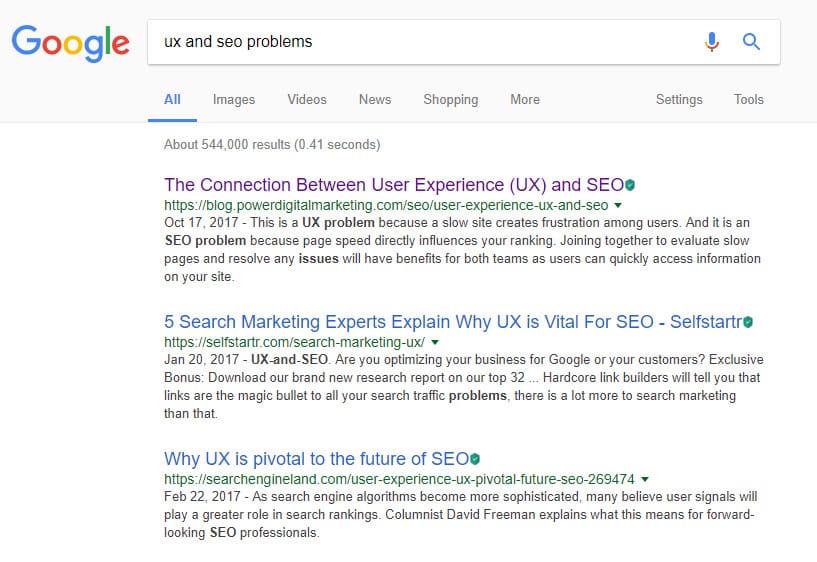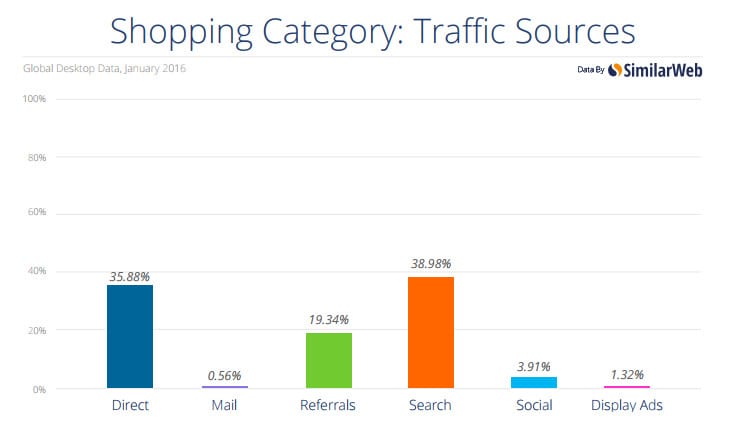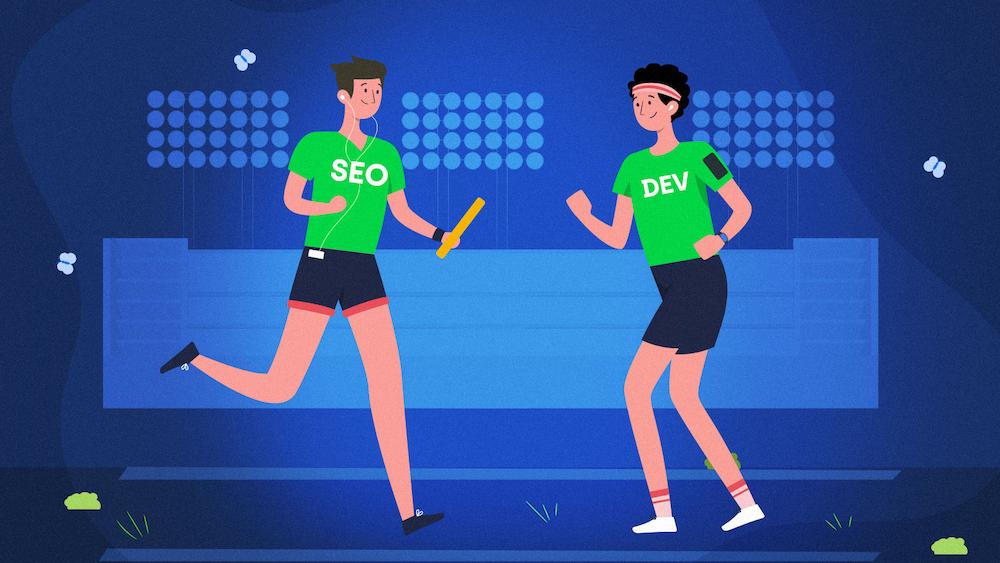One could think that the days of the infamous SEO vs. UX war are long over. The sins of the SEO community were numerous: keyword stuffing, spamming the web with link farms, cloaking, hidden links, and so on. These very user-unfriendly sins were repented by SEOs and thus abandoned (or Google made them – depending on your point of view).
Nowadays, SEO and UX are no longer enemies, but I wouldn’t describe them as friends either. They are more like coworkers who don’t like each other very much but are forced to work together on a project – they tolerate each other at best, even though both UX and SEO experts like to claim otherwise.

Let’s just admit it: UX specialists very often despise search engines and would like to make beautiful responsive websites that no one would visit because they would be close to impossible to find. On the other hand, we SEOs very often treat UX and the users in general as an unnecessary addition to our perfectly optimized (for robots) website. It’s not as bad as it used to be, but we still don’t like each other very much. And that’s fine – we don’t have to love each other to cooperate with one another. But there’s still a lot we could be learning from each other.
What SEOs can learn from the UX experts
Go shallow or go home
We know that search engines prefer shallow website structures. Users usually don’t know what a website structure is, but they know they want to have everything the website has to offer no further than a few clicks from the homepage. Shallow structures are not only easier to crawl but also easier to navigate. Googlebot might be patient enough to go as far as 10 “clicks” from the homepage, but the users won’t be as forgiving.
Need for speed
Remember the times when you had to wait patiently for the dial-up internet connection? Well, I don’t, but I think we can all agree – having to wait for a website to load is a huge no-no, especially now in the mobile era. We – the users – want our results accurate, and we want them fast. Sometimes speed is even more important than accuracy.
Website speed has been a Google ranking factor since 2010. We know that in order to rank high (especially on mobile), we need fast websites. We know the tools to check page speed and the tricks to improve it. But what we do after GTMetrix tells us to defer parsing of the JavaScript is another story. What part of it should we defer? All of it? Some of it? In this case, there is one very simple rule to follow: think about the users (the people that use search engines to find your website) and render the parts that would interest them the most first. This means the page content and its main functionalities, such as navigation. These things should differ depending on the website’s main purpose.
Of course, the website’s load speed depends on many factors, and we cannot control all of them. The user’s internet connection speed and the device they use being two examples. When optimizing the website’s speed, one should keep all of those factors in mind, so that they can be sure that when the last person on Earth who uses the dial-up connection finally hears the “ping,” they will get the information they are looking for on the website as soon as possible.
Persona very grata
Think about the users who will visit your website since it’s ranked no. 1 for the best keywords. What do you see? Think about their age, gender, occupation. What time of day do they visit your website? From which device? What do they expect to find? Which tone of voice will be the most suitable for them?
Google and other search engines want to serve their users the best results, but they still don’t understand all the language nuances (not to mention the images and the website’s layout). Seniors, for instance, might find it off-putting if the copy in the online shop that specializes in walkers was written in a too personal or informal manner, or if it was illegible to them due to small fonts or a poorly chosen contrast. There’s no need to create a detailed user profile, but it wouldn’t hurt to ask ourselves what our target audience is and keep them in mind while creating the website’s layout and copy.
Prototype
It’s always good to try out different stuff (as long as it’s legal and you have consent). It’s also true when it comes to web design and SEO. Don’t be shy to try out different navigation styles and website structures, and don’t worry if the budget is tight. Get yourself a piece of paper and something to draw with (use crayons if you want to evoke childhood nostalgia).

OK, the paper part isn’t obligatory, you can do this on your computer as well. Now – no matter if you are trying to come up with the new information architecture, navigation menu, heading structure, or something as simple as the meta description template – don’t stop after the first version. Create some alternatives and ask your team to help you choose the best ones. Now move to the testing phase (don’t worry – I will describe it in detail in the next paragraph). Choose the best option but don’t rush to make it live. Hosting the new solutions on the staging or other beta-server to see if they work as they should is not only good practice, but also a part of prototyping.
When in doubt, go for testing
Actually, you should go for testing even when not in doubt. Whether you work as an in-house SEO or deal with many different clients in an SEO agency – it’s very likely that you’ve been working with a given website for a very long time. So long that many things related to your niche may appear obvious to you, when in fact, they’re not obvious at all. In such cases, testing comes to the rescue. Even though testing is a typical UX tool, I believe SEOs can also find it helpful, especially when redesigning or building a completely new website structure. If you have a bunch of meta description template ideas, you can just try them out on your live website and see how they affect the CTR.
On the other hand, while testing something as huge and important as information architecture, you might really want to invite the potential users to the table. Don’t worry, you don’t need to invite people off the streets and prepare a professional testing environment: ask a coworker from another department or your uncle (you can take advantage of his constant questions about your work and what the hell you actually do with this “SEO”) if your copy is good and easy to read, or if the website structure is easy to navigate. Ask them to complete a simple task (“you want to find and buy X,” “Find information on Y on this website”) and observe the entire process (be careful not to give them any hints!).
What UX experts can learn from SEOs
Users don’t appear out of thin air…
Yes, even in the age of social media, your precious users still use those terrible search engines to find websites. This may vary depending on the industry, but in general, search is still king when it comes to bringing users to e-commerce websites. Direct traffic is almost as important, but let’s be honest – in order to remember you, they need to get to know you first. And sometimes, even if they know you and like you, they might forget your brand name because that’s just the way human memory works. In those cases and in all other cases – you really want them to find you. Let’s face it: it’s not much of a “user experience” without the users.

…and they don’t always start from the homepage –
This is something UX specialists often tend to forget. You can design an amazing, life-changing journey on your homepage – but what happens if a user goes directly from SERP to the product page? I know – this would have never happened if the one-page website you wanted so bad was implemented. But in the cases where one-page websites don’t apply (or they could apply, but your SEO forbids them), keep in mind that you should design multiple experiences, not only the linear one.
Research your keywords
I know, keyword research lies in the SEO realm. It’s used to create a useless copy that nobody will read (except the bots and maybe the copywriter). What value can it provide for the UX? Well, it can give you a grasp of what people think. Sure, you can perform user testing, interviews, and surveys – but as quantum mechanics proved, the mere act of observation can affect the object that is being observed. In other words: don’t trust your surveys that much. Keyword data, on the other hand, is always true – it reflects the way people think and search – their intentions, expectations, and the vocabulary they use. Keyword data is pure gold.
Meet your two new best friends
You need to know Google Search Console and Analytics. I know UX has a wide variety of advanced tools to track the users’ behavior and interaction with a website. But let’s not forget about those two – they’re free, relatively easy-to-use, and since your website should have been integrated with them since the beginning, it can provide a lot of historical data. CTR, bounce rates, average session duration, and much more data are available in those tools and can give you an idea about which pages are performing below or above average, thus – which solutions are the best.
Not everyone watches the videos
We live in a constant hurry and more and more people find spending even 5 minutes of their lives on a video unnecessarily (unless it features puppies or kittens, but let’s be honest – you can’t put cute animals in every video, we don’t live in an ideal world). Sometimes, users just want to directly “scan” the text to find the information they’re looking for. Sometimes they don’t want to annoy their boss or teacher with the loud autoplay and just want to enjoy a short article during the boring meeting or lecture. Let’s not forget about the people using screen readers and, last but not least – search engine bots which are still almost blind to such resources. Don’t get me wrong: the videos are a great way to explain things and engage the audience. But the videos themselves won’t do the trick – they need to be found first. So don’t make me watch a fifteen-minute video without providing a text summary/description below it. A significant part of your audience and the bots will be grateful.
Conclusion: let’s bury the hatchet (and go make great websites)
Looking up to Google as the almighty god we want to please (and the other search engines in its pantheon), we tend to forget that it’s just a company that wants to make money by providing its users the best service. And in this case, the “best service” literally translates to the best search results. Google wants its users to be happy with the results it provides them. UX wants users to be happy too. Coincidence? I don’t think so.
With the increasing importance of the user experience in the all-seeing eyes of Google, SEOs can no longer reduce users to the number of page views their websites receive. The science-fiction post-apocalyptic reality where web spiders gain sentience and try to murder the lousy webmasters is still fiction and will remain fiction for a long time. But one thing we do know for sure is that Google is going to pay more and more attention to the UX-related factors. And so should we.








